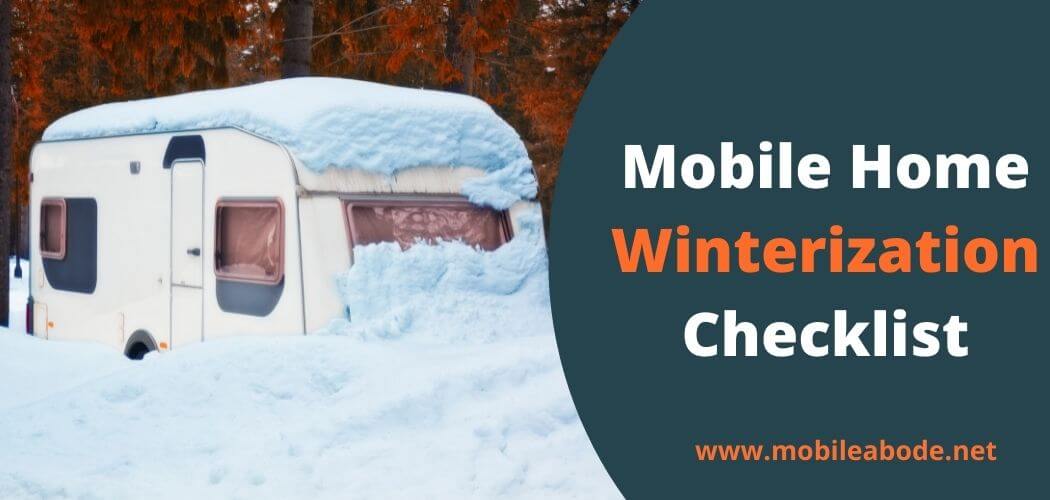A lot of people are unaware that they need to winterize their mobile homes. This is because the weather in most places doesn’t get too cold for them, so there’s no need.
However, if you live in a place where it gets really cold during the winter months then this article will teach you how to protect your investment and keep your mobile home warm during those colder days.
The first thing you’ll want to do is close off any open windows or doors on your mobile home. You can also seal up cracks around windows with caulking or foam insulation, but make sure not to cover vents or anything like that!
If there are gaps inside of your walls (like behind appliances) then use spray foam insulation to fill them up as best as you can.
Also Read: How To Winterize RV Without Antifreeze?
If your home has skirted around it, make sure to fill up the gaps with either insulation or soil so that the cold air doesn’t blow in.
One of the most important things to do is to keep your mobile home well-ventilated. This means opening up vents and leaving cabinets open (especially kitchen and bathroom cabinets). You can also install a small electric heater in each room to help keep them warm.
Lastly, make sure to keep an eye on your propane levels! If they get too low then you won’t be able to heat your home properly.
By following these tips, you’ll be able to keep your mobile home and cozy all winter long!
How to Winterization a Mobile Home? Checklist
If you live in a mobile home, it’s important to take the necessary precautions to protect your home during winter.
Use this checklist to make sure your mobile home is winterized and ready for the coldest months.
- Insulate your home: Adding insulation will help keep your home warm during winter.
- Seal windows and doors: Sealing your windows and doors will help keep the heat in your home. (How to Insulate a Mobile Home Roof?)
- Replace worn weather stripping: Worn weather stripping can let cold air into your home.
- Inspect your roof: Make sure your roof is in good condition and is properly sealed.
- Install storm windows and doors: Storm windows and doors can help keep the cold air out of your home.
- Add a space heater: A space heater can help keep your home warm during winter.
- Power down: Unplug appliances and turn off the water to ensure they don’t damage during winter.
- Shut off water: Turn off the main water line and drain your home of any remaining water.
- Drain and winterize: Drain all leftover water from your appliances and leave them open to prevent freezing during the winter months.
Check with your local community for specific mobile home winterization laws or regulations, as well as any other important tips you may need to know to keep your home safe throughout the coldest months of the year.
Remember that although it’s not possible to eliminate all chances of pipes freezing, having a well-insulated home will reduce the likelihood of frozen pipe problems.
Also, remember that it’s best to avoid leaving the faucets running for extended periods during winter.
What is the best insulation for under a mobile home?
The best insulation for under a mobile home is typically a foam board or spray foam. These materials provide the best R-value, which measures how well they resist heat flow, and they also create a tight seal that helps prevent air leaks.
Polyurethane foam is one of the most popular options because it’s relatively inexpensive and easy to install. It’s important to choose a board that’s specifically designed for use under mobile homes, though, as regular foam boards may not provide enough support.
Spray foam is another great option for insulating under a mobile home. It can be more expensive than foam board, but it’s also much easier to install and provides better insulation. It’s important to choose a high-quality spray foam, though, as some products may not provide adequate insulation or may be difficult to apply.
Whether you choose foam board or spray foam, make sure to seal any gaps or cracks around the edges of the insulation to ensure that your mobile home is well-protected from the elements.
What temperature do pipes freeze under the mobile home?
Pipes can freeze at temperatures as low as 20 degrees Fahrenheit, so it’s important to take steps to protect your plumbing if the temperature outside drops. Mobile homes are particularly vulnerable to freezing pipes because they’re often not as well-insulated as traditional homes.
There are a few things you can do to prevent your pipes from freezing in cold weather:
- Keep your thermostat set to at least 55 degrees Fahrenheit, even when you’re not home.
- Open cabinet doors to allow heat to reach pipes that run through unheated areas, such as cabinets and closets.
- Seal any cracks or gaps around doors and windows to keep the cold air out.
- If you’re going to be away from home for an extended period, have someone check on your property regularly to make sure the heat is still working and that there’s no water leaking from frozen pipes.
Taking these precautions will help ensure that your pipes don’t freeze and burst when the temperature outside drops.
Wrap Up
Winterization of a mobile home can be done in a few simple steps. By following these tips, you can keep your mobile home warm and protected from the winter weather.
Have you ever winterized a mobile home? What tips would you add to this list?

